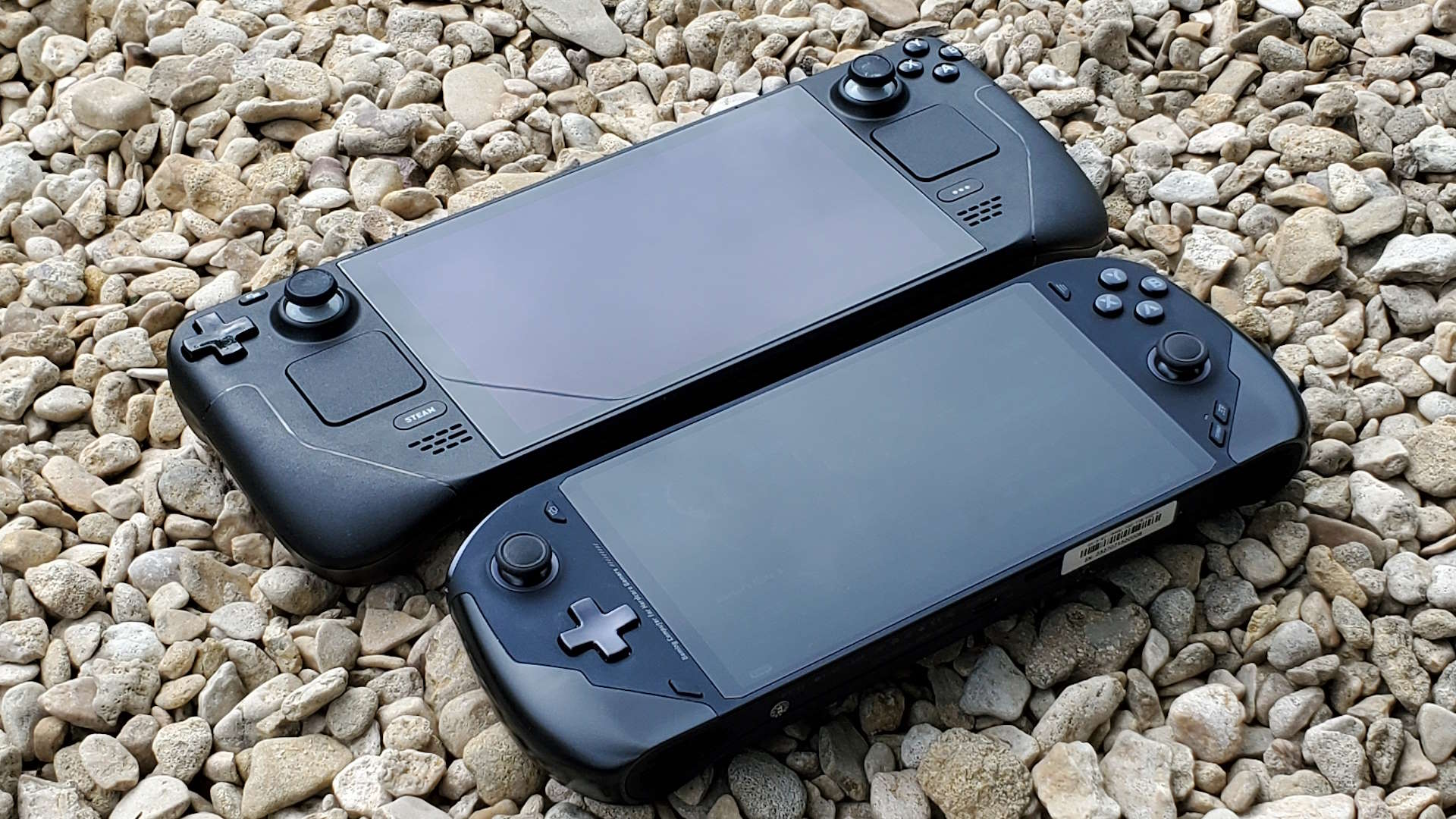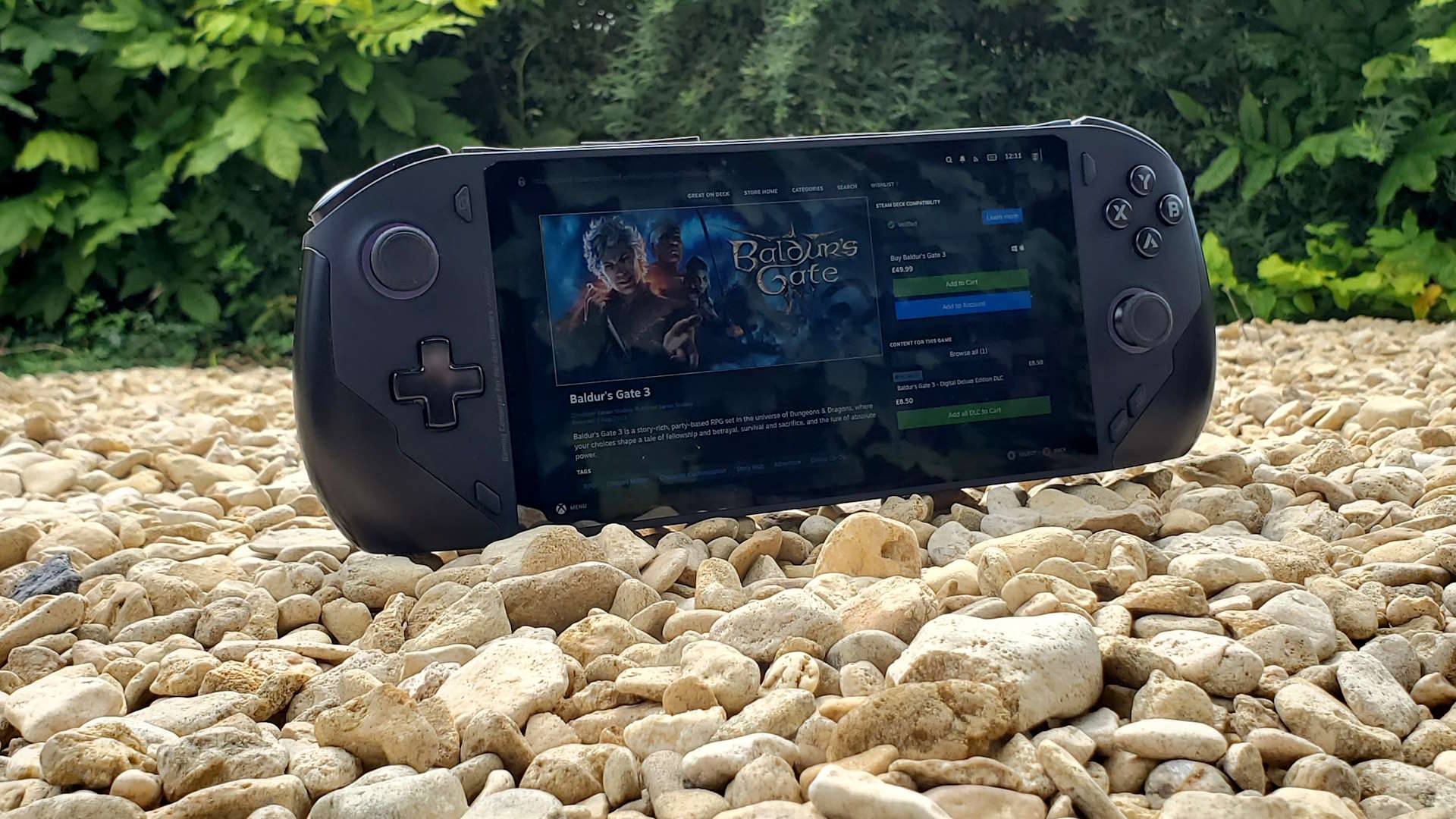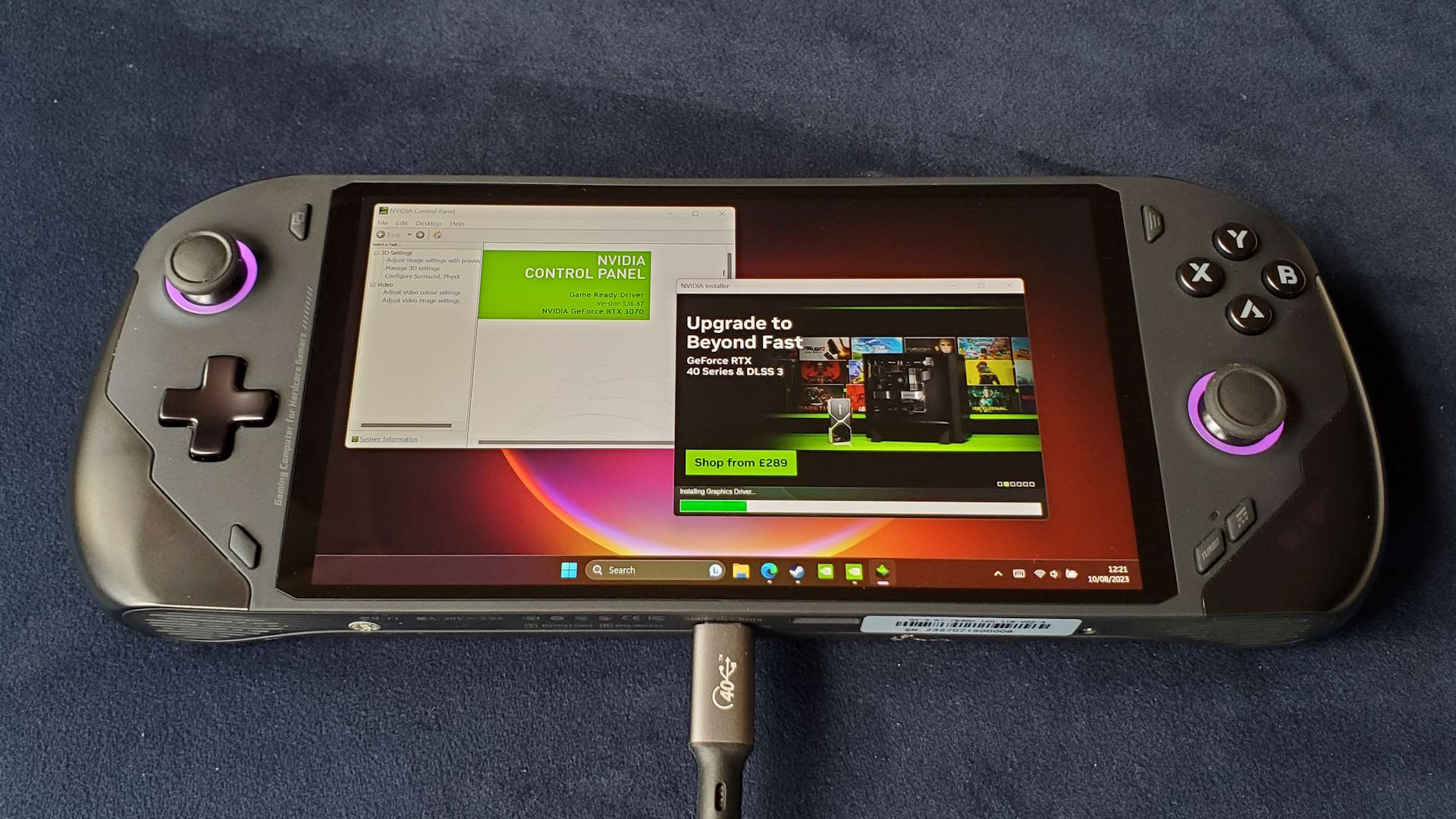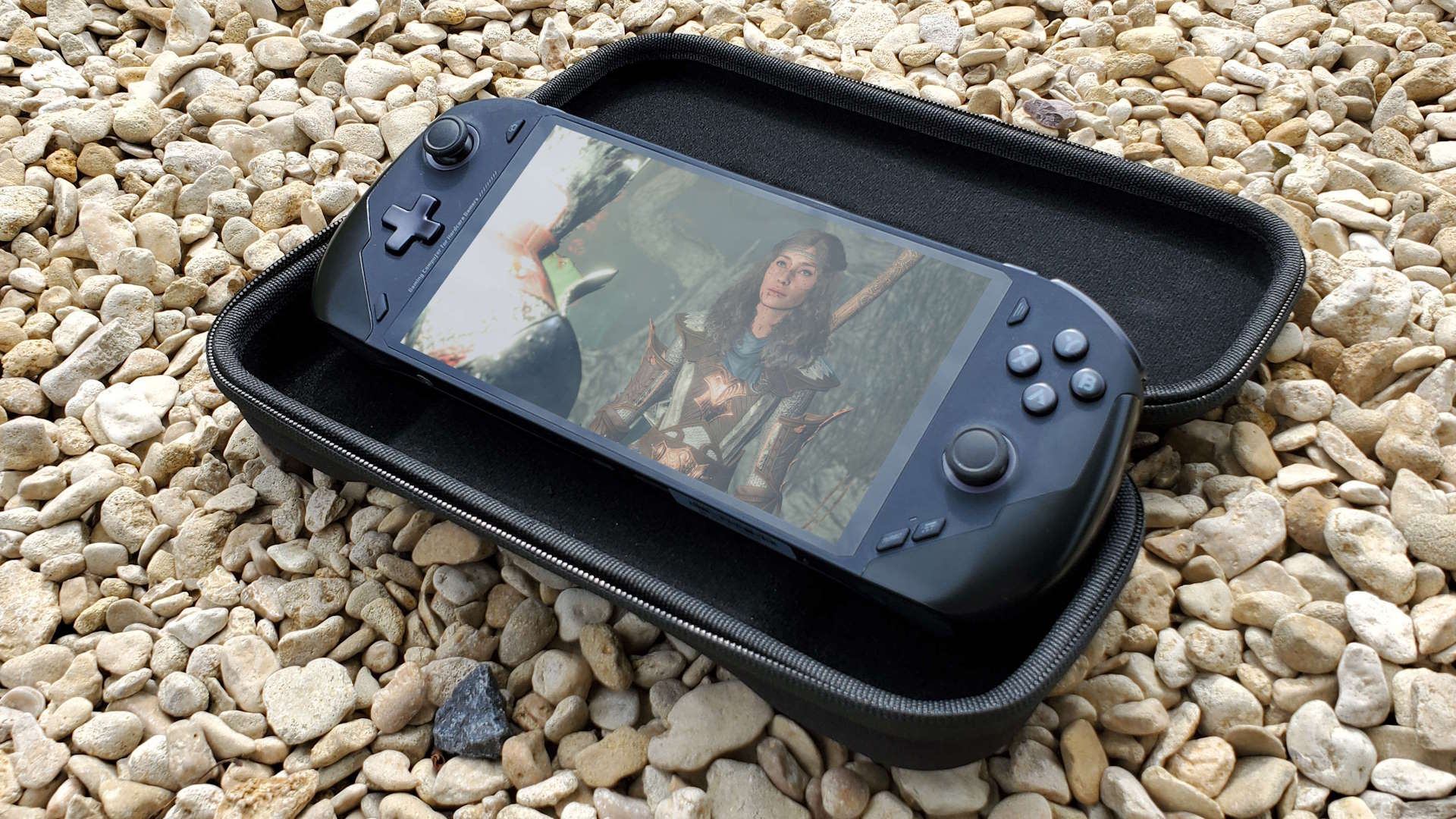Our Verdict
The OneXFly may not be the smallest of the new handheld gaming PCs around, but it's getting close to that Nintendo Switch aesthetic, and is a lovely gaming machine all the same. It's powerful, versatile, and feels great in the hands.
For
- That AMD chip is a hero
- Screen is bright and crisp
- Feels good in the hands
- Lots of ports
- Quiet
Against
- Battery life will always be on your mind
- Slightly wobbly top USB4 connection
- Expensive
- Software is only okay
PC Gamer's got your back
The dream of playing PC games in bed has been the long-held desire of the handheld gaming PC crew. "I can't wait to play [insert relevant indie game here] in bed on the Steam Deck!' was the cry from large swathes of the PC Gamer team when Valve launched its assault on the somewhat stagnant market.
But 18 months, some regular wrist cramps, and a couple of black eyes later and the general consensus is that the Steam Deck isn't the device you want to be gaming on in bed. The weight and girth of the Deck just make it an uncomfortable bedfellow, and your other boudoir companions are unlikely to appreciate it either given the god-awful racket the over-enthusiastic fans make even when you're just zipping around in Olli Olli World, either.
But your bedroom—and honestly most other places—will be happy homes for the new OneXPlayer OneXFly handheld. It's been designed to be smaller than both the Steam Deck and the ROG Ally, and lighter, too. And it really is a lovely little piece of hardware.
And, lying back in bed, the OneXFly is fulfilling the promise of that original handheld PC dream.
✅ You want a smaller handheld but with a decent screen: The OneXFly's 7-inch panel has a thin bezel which has allowed it to cut the overall footprint down.
✅ You hate the noise of the Steam Deck: The fan sound of the OneXFly is quiet, even at high speeds. It's also simple to adjust the fan curve from the OneXConsole software.
❌ You're looking for a cheap second PC: The $739 spec is probably still the one I'd choose—that $1,299 64GB RAM/4TB SSD version is silly—but it's still far more than a low-end Steam Deck.
I was impressed with the Steam Deck, a big fan of the ROG Ally—when it wasn't melting SD cards—and have loved the big screen capabilities of the AOKZOE A1 Pro. This latest device is a stablemate of the A1 Pro, sharing the same software, and a lot of the same hardware, too. And that's no bad thing as a whole.
I had some language and OS issues with our prototype review unit initially, but once I'd reinstalled a fresh version of Windows and added the full driver and application suite, those problems evaporated.
While I don't love the OneXConsole application, it's effective enough at giving you easy control over the system, from TDP to CPU clock speed and whether you allow it to Turbo, too. You can also control the RGB, because that's now a thing handheld gaming PCs need. Y'know, just like regular gaming PCs.
In fairness, the OneXFly's lighting is pretty sweet, with soft, multicoloured illumination around the twin sticks and even custom RGB lighting around each palm rest. Though, honestly, I've spent most of my time with the LEDs disabled in order to squeeze every last drop of power out of the 48Wh battery inside it.
For a handheld, it's all about that longevity away from the plug socket, after all. And the OneXFly can comfortably outlast the ROG Ally, even running the awesome Ryzen 7 7840U at the full 30W TDP. With every at max, including the Windows power settings, the OneXFly delivers 69 minutes of gaming uptime measured by the PCMark 10 gaming battery test.
The much larger A1 Pro has a commensurately larger battery, hence its higher performance in the battery life testing of a full hour and a half.





Processor: AMD Ryzen 7 7840U
Cores | Threads: 8 | 16
GPU: AMD RDNA 3 12CUs
Memory: 16/32/64GB LPDDR5X-7500
Screen: 7-inch
Resolution: 1920 x 1080
Refresh rate: 120Hz (60Hz tested here)
Peak luminance: 450cd/m²
Battery: 48Wh
I/O: 2x USB 4.0 Type-C, 1x USB 3.2 Type-A, 3.5mm audio, MicroSD
Dimensions: 264 x 98 x 23mm
Weight: 580g
Price:
16GB | 512GB | $739
32GB | 1TB | $889
32GB | 2TB | $969
64GB | 2TB | $1,199
64GB | 4TB | $1,299
But you're not going to be playing at those levels, unless you are connected to a power source, in which case those time measures are irrelevant. You'll be doing exactly what we've been doing with the Steam Deck since it launched, figuring out just how far we can drop the system settings before it stops being fun to play a given game.
This is where the benefit of that AMD Ryzen APU comes in, because the CPU side is ludicrously good, while the Radeon 780M RDNA 3 integrated GPU is surprisingly adept at 1080p gaming, generally on medium game settings. The same even rings true when I've been cutting TDP down to 15W to play Baldur's Gate 3.
And it's an excellent BG3 machine, too. The screen is bright, at 450cd/m2 though our engineering sample unit isn't capable of the 120Hz refresh rate the retail units will offer. But it's still super sharp, responsive, and clear. That's important when trying to pick out the next target for the Crown of Madness on a 7-inch display.
The rest of the base spec is pretty standard for the current crop of gaming handhelds—16GB RAM, 512GB SSD—but it's using a speedier version of memory in its LPDDR5X-7500 kit. And that makes it a super responsive Windows-based gaming machine.
Yes, Windows. We are still talking about Windows 11 as the OS of choice for every handheld outside of Valve, because it still hasn't released a proper version of its Linux-based OS to use away from the Steam Deck. And I'm actually okay with that now. Microsoft's operating system doesn't have any optimisations for handheld machines as yet, and will still throw the occasional issue your way.


Thankfully, it's Windows so there's generally an easily found solution. And often it's purely a question of hitting the clear screen button, ignoring it, or going the nuclear option and rebooting. And you can always boot directly into Steam's Big Picture mode and forgo any Windows tiny touchscreen problems.
But, because it is Windows, it makes a fantastic docked gaming PC, especially with the fast RAM and outstanding CPU component. And the OneXFly is far better specced out than the ROG Ally, too, making it a better fit for external GPU boxes.
I've been running it plumbed into a Razer Core X box with an RTX 3070 inside and it was a doddle to get up and running with the latest standard desktop Nvidia drivers. It doesn't need to be rebooted if you want to switch; just plug the Thunderbolt/USB4 cable in and it will spin up the GPU and connect.
My only problem is that, while the OneXFly does have two full USB4 Type-C ports on the top and bottom of the chassis, they are not the same. They have different housing and I found the top offered by cable too much travel, resulting in it dropping the connection to the eGPU far too often. The underslung Type-C port, however, is much more robust.
That's not it for connections either, as there's a full USB 3.2 Type-A port on the top, too. Even if you're jamming it into a USB dock there are still ports free on the device itself. That's not something you can say for the resolutely single port ROG Ally and its determination that you only use Asus' eGPU.
That's one way to up the performance of the OneXFly, but then you've also got GeForce Now or Xbox Cloud Gaming as streaming services. The experience on a good Wi-Fi network is outstanding, and means you will exponentially increase your battery life; it's effectively just playing a video at that point. And both are easy to get running on a Windows system.


I will say, it's not cheap. And that's where the Steam Deck still holds sway over any handheld being launched at the moment.
So, the specs are good, the slim bezel screen is neat, and the performance right up there. I'm also liking the physical design of the thing. It's certainly thick, but the overall footprint is far smaller than either Deck or Ally, and that makes it something I'm far more likely to just drop into a bag when I head out the door.
It also feels good in the hand. The rubberised coating feels grippy without feeling sticky—it's kinda like how I imagine Batman's cowl would feel—and even this black version isn't the fingerprint magnet I was expecting it to be.
I will say, it's not cheap. And that's where the Steam Deck still holds sway over any handheld being launched at the moment. They may have higher specs, but when you can pick up a low-end Deck, swap in a cheap high-capacity 2230 SSD for around $400, that puts it far more in second-machine territory than the $739 price tag of the lowest spec version of the OneXFly.
At that price, it's a primary machine. It's the only one you use. Can it replace your laptop? That's a toughie. If we're just talking gaming, then 100%. You've got a wee thing to take around with you to play practically any PC game on, and then when you get home it has the power to make an effective desktop PC when you dock it into a screen, mouse, and keyboard.
But it's not like you're going to be able to take notes on your OneXFly in class, or rock up to a business meeting and easily run a PowerPoint presentation without looking like a proper tool.
It's a great little device, though. I still love the huge 8-inch screen of the A1 Pro, and its beefy battery, but it's massive. The OneXFly is a genuinely portable, genuinely powerful handheld, with a whole lot of versatility baked into it. I don't love the software, not in the way I've recently become rather enamoured with the AYASpace, and Windows certainly has its quirks. But I couldn't go back to the Steam Deck now, and the ROG Ally, SD card issues aside, feels too limited for me.
So, it looks like it'll be the OneXFly that accompanies me on my travels from now on.
The OneXFly may not be the smallest of the new handheld gaming PCs around, but it's getting close to that Nintendo Switch aesthetic, and is a lovely gaming machine all the same. It's powerful, versatile, and feels great in the hands.

Dave has been gaming since the days of Zaxxon and Lady Bug on the Colecovision, and code books for the Commodore Vic 20 (Death Race 2000!). He built his first gaming PC at the tender age of 16, and finally finished bug-fixing the Cyrix-based system around a year later. When he dropped it out of the window. He first started writing for Official PlayStation Magazine and Xbox World many decades ago, then moved onto PC Format full-time, then PC Gamer, TechRadar, and T3 among others. Now he's back, writing about the nightmarish graphics card market, CPUs with more cores than sense, gaming laptops hotter than the sun, and SSDs more capacious than a Cybertruck.


